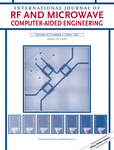Design and analysis of a compact ultrathin ultra-wideband metamaterial absorber with near to unity absorption for Ku-band
Funding information: M/s HAMA IoT Solutions Private Limited
Abstract
The proposed work intend to develop a compact ultrathin ultra-wideband (UWB) metamaterial absorber with a feature of near to unity absorption. The proposed absorber is identified by one consolidated patch in combination with L-shaped patches. The proposed absorber provides more than 97% absorption from 13.6 to 18.5 GHz, the operating band of the absorber is ultra-wide with a bandwidth of 4.9 GHz. The proposed structure exhibits full width half maximum (FWHM) of approximately 6.6 GHz from 12.5 to 19.1 GHz. The design of the structure is having a thickness of 0.072 λ0 relative to the lowest frequency (at 13.58 GHz) of the UWB. The structure with compact size (9 mm × 9 mm × 1.6 mm) compensates for the marginal rise in dimension with ultra-wideband absorption having an absorptivity of above 97% in comparison to existing UWB absorber available in commercially exploitable microwave frequency. The evolution process incorporates incremental changes in the design of the absorber thereby witnessing experimentally verified more than 97% absorptivity. The in-depth analysis of the proposed structure is done with incident and polarisation angle analysis. The current and field distribution validates the effectiveness of the UWB metamaterial based microwave absorber.
Open Research
DATA AVAILABILITY STATEMENT
The data that support the findings of this study are available from the corresponding author upon reasonable request.




